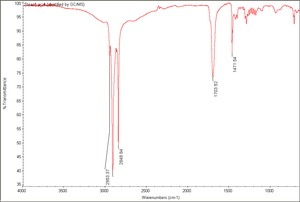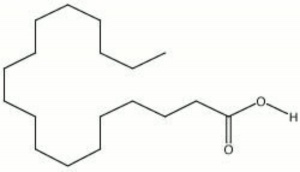Stearic acid
Description
White, waxy fatty acid. Stearic acid occurs naturally in animal fats, Tallow, and, to a smaller extent, vegetable fats. Lard and tallow can contain up to 30% stearic acid. Stearic acid is a long-chain saturated triglyceride with no double bonds that can be readily saponified with alkaline salts. Most commercial stearic acid products, such as U.S.P. stearic acid, contain are a mixture of 50% stearic acid, 45% Palmitic acid, and 5% Oleic acid. Stearic acid is used as a lubricatant, softener, and dispersing agent in soaps, candles, lubricants, ointments, cosmetics, rubber, polishes, coatings, and food packaging.
Synonyms and Related Terms
n-octadecanoic acid (IUPAC); Emersol 132; Promulsin; Proviscol Wax. U.S.P. stearic acid; kyselina stearová (Ces.); Stearinsäure (Deut.); ácido esteárico (Esp.); acide stéarique (Fr.); (It.); stearinezuur (Ned.); kwas stearynowy (Pol.);
Risks
- Combustible.
- ThermoFisher: SDS
Physical and Chemical Properties
Almost insoluble in water.
| Composition | CH3(CH2)16COOH |
|---|---|
| CAS | 57-11-4 |
| Melting Point | 69.6 C |
| Density | 0.8390 g/ml |
| Molecular Weight | mol. wt. = 284.47 |
| Refractive Index | 1.4299 |
| Boiling Point | 361-383 C |
Resources and Citations
- G.S.Brady, Materials Handbook, McGraw-Hill Book Co., New York, 1971 Comment: p. 770
- Richard S. Lewis, Hawley's Condensed Chemical Dictionary, Van Nostrand Reinhold, New York, 10th ed., 1993
- The Merck Index, Martha Windholz (ed.), Merck Research Labs, Rahway NJ, 10th edition, 1983 Comment: entry 8959
- A Glossary of Paper Conservation Terms, Margaret Ellis (ed.), Conservation Center of the Institute of Fine Arts, New York City, 1998
- Encyclopedia Britannica, http://www.britannica.com Comment: "stearic acid" [Accessed 25 Jan. 2006].
- Wikipedia: http://en.wikipedia.org/wiki/Stearic_acid (Accessed Feb. 10, 2006)
- Random House, Webster's Encyclopedic Unabridged Dictionary of the English Language, Grammercy Book, New York, 1997
- The American Heritage Dictionary or Encarta, via Microsoft Bookshelf 98, Microsoft Corp., 1998

